Grief and Bereavement Essay
VerifiedAdded on 2019/11/12
|10
|2836
|697
Essay
AI Summary
This essay delves into the multifaceted nature of grief and bereavement, exploring the various reactions individuals experience following loss. It defines grief as a normal response to loss, influenced by cultural, religious, and personal factors. Bereavement is described as the period following loss, characterized by grief symptoms affecting physical, mental, and social well-being. The essay highlights that grief responses vary, depending on the nature of the loss and the individual's relationship with the deceased. It then introduces Worden's four tasks of grieving: accepting the reality of loss, experiencing the pain of grief, adjusting to an environment without the deceased, and reinvesting emotional energy into new relationships. The essay analyzes the strengths and weaknesses of Worden's model, acknowledging its flexibility while noting criticisms regarding its lack of timeframes and potential for grievers to become stuck in certain stages. Ultimately, the essay concludes that understanding grief and bereavement is crucial for supporting individuals through this challenging process, and that models like Worden's can provide valuable guidance.
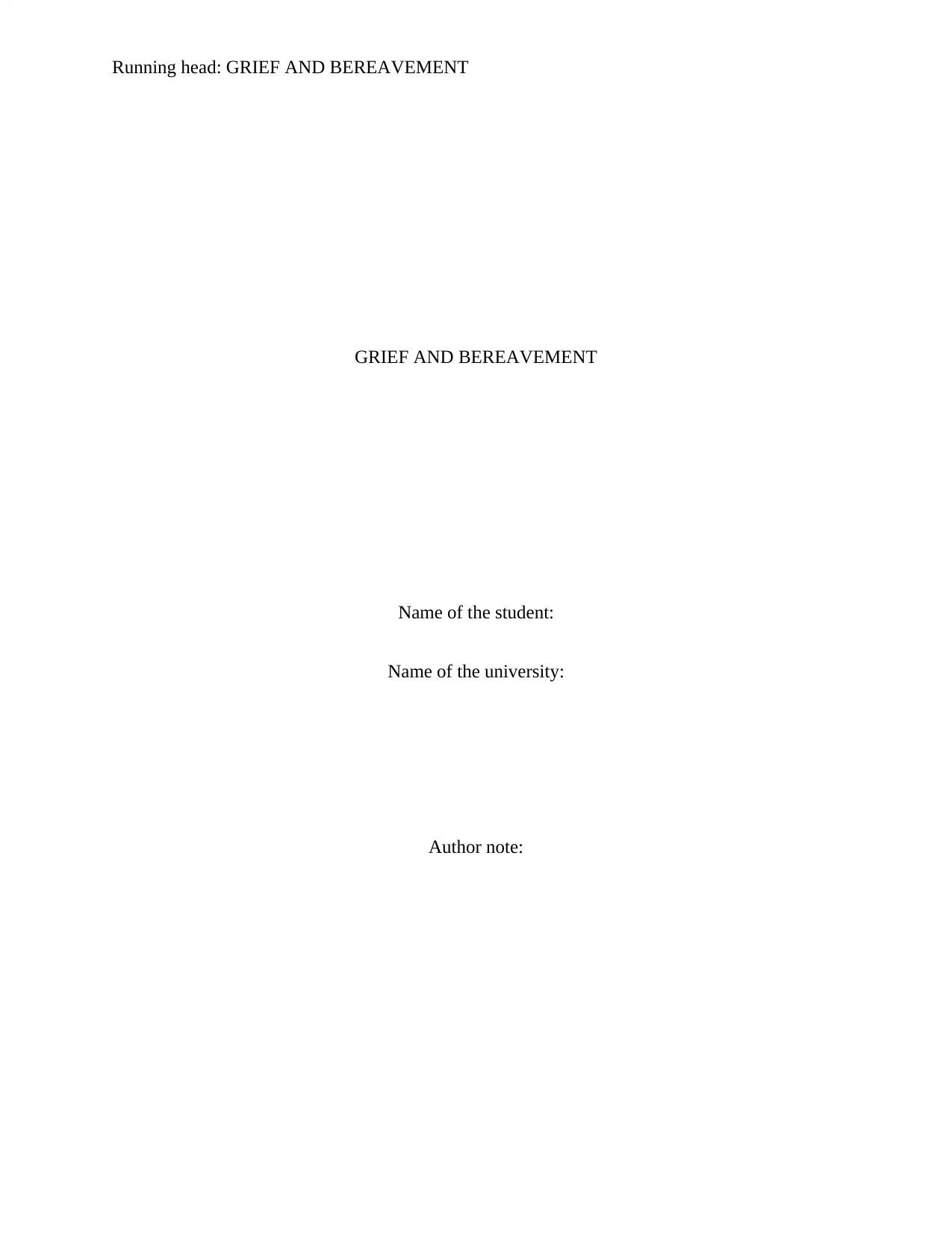
Running head: GRIEF AND BEREAVEMENT
GRIEF AND BEREAVEMENT
Name of the student:
Name of the university:
Author note:
GRIEF AND BEREAVEMENT
Name of the student:
Name of the university:
Author note:
Paraphrase This Document
Need a fresh take? Get an instant paraphrase of this document with our AI Paraphraser
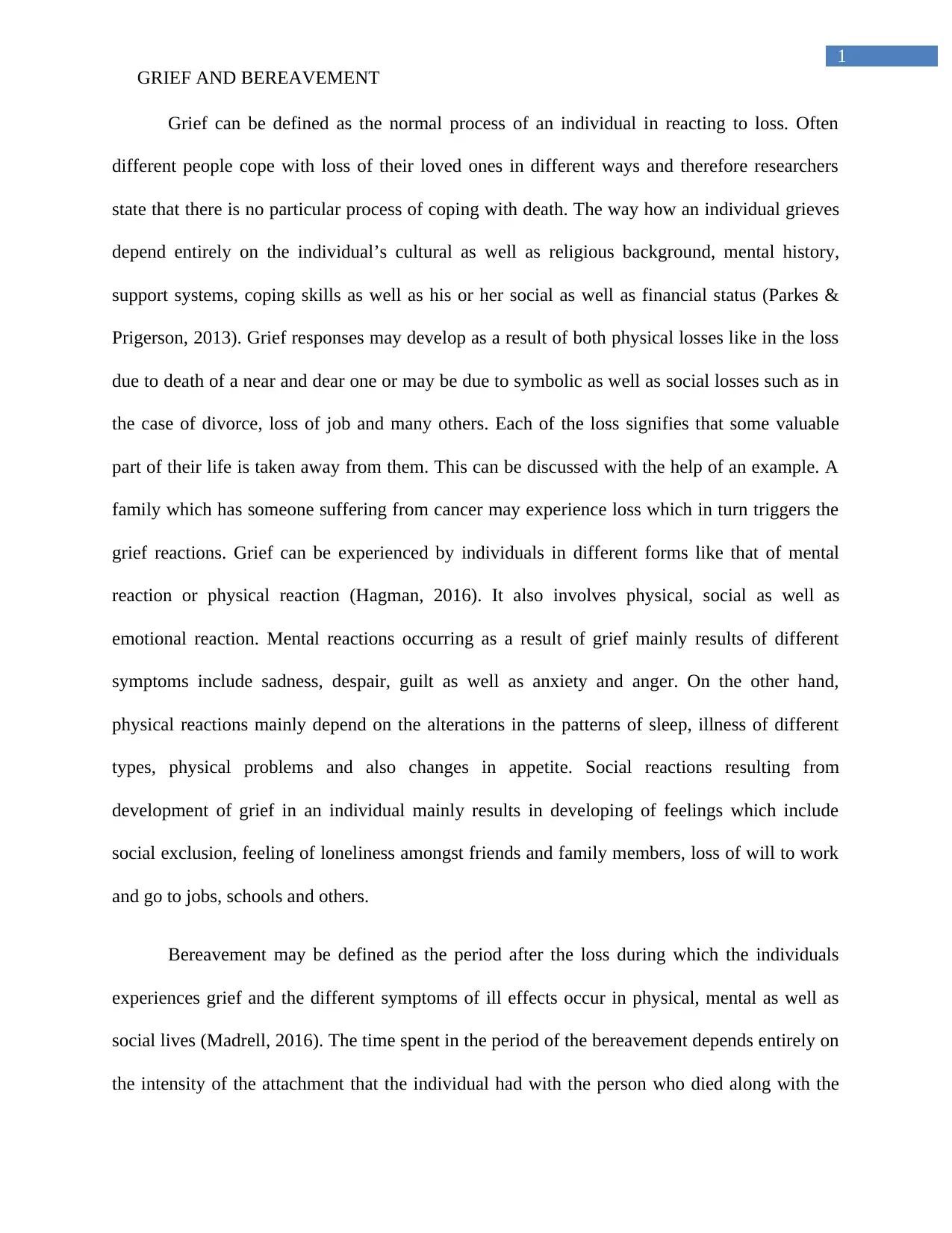
1
GRIEF AND BEREAVEMENT
Grief can be defined as the normal process of an individual in reacting to loss. Often
different people cope with loss of their loved ones in different ways and therefore researchers
state that there is no particular process of coping with death. The way how an individual grieves
depend entirely on the individual’s cultural as well as religious background, mental history,
support systems, coping skills as well as his or her social as well as financial status (Parkes &
Prigerson, 2013). Grief responses may develop as a result of both physical losses like in the loss
due to death of a near and dear one or may be due to symbolic as well as social losses such as in
the case of divorce, loss of job and many others. Each of the loss signifies that some valuable
part of their life is taken away from them. This can be discussed with the help of an example. A
family which has someone suffering from cancer may experience loss which in turn triggers the
grief reactions. Grief can be experienced by individuals in different forms like that of mental
reaction or physical reaction (Hagman, 2016). It also involves physical, social as well as
emotional reaction. Mental reactions occurring as a result of grief mainly results of different
symptoms include sadness, despair, guilt as well as anxiety and anger. On the other hand,
physical reactions mainly depend on the alterations in the patterns of sleep, illness of different
types, physical problems and also changes in appetite. Social reactions resulting from
development of grief in an individual mainly results in developing of feelings which include
social exclusion, feeling of loneliness amongst friends and family members, loss of will to work
and go to jobs, schools and others.
Bereavement may be defined as the period after the loss during which the individuals
experiences grief and the different symptoms of ill effects occur in physical, mental as well as
social lives (Madrell, 2016). The time spent in the period of the bereavement depends entirely on
the intensity of the attachment that the individual had with the person who died along with the
GRIEF AND BEREAVEMENT
Grief can be defined as the normal process of an individual in reacting to loss. Often
different people cope with loss of their loved ones in different ways and therefore researchers
state that there is no particular process of coping with death. The way how an individual grieves
depend entirely on the individual’s cultural as well as religious background, mental history,
support systems, coping skills as well as his or her social as well as financial status (Parkes &
Prigerson, 2013). Grief responses may develop as a result of both physical losses like in the loss
due to death of a near and dear one or may be due to symbolic as well as social losses such as in
the case of divorce, loss of job and many others. Each of the loss signifies that some valuable
part of their life is taken away from them. This can be discussed with the help of an example. A
family which has someone suffering from cancer may experience loss which in turn triggers the
grief reactions. Grief can be experienced by individuals in different forms like that of mental
reaction or physical reaction (Hagman, 2016). It also involves physical, social as well as
emotional reaction. Mental reactions occurring as a result of grief mainly results of different
symptoms include sadness, despair, guilt as well as anxiety and anger. On the other hand,
physical reactions mainly depend on the alterations in the patterns of sleep, illness of different
types, physical problems and also changes in appetite. Social reactions resulting from
development of grief in an individual mainly results in developing of feelings which include
social exclusion, feeling of loneliness amongst friends and family members, loss of will to work
and go to jobs, schools and others.
Bereavement may be defined as the period after the loss during which the individuals
experiences grief and the different symptoms of ill effects occur in physical, mental as well as
social lives (Madrell, 2016). The time spent in the period of the bereavement depends entirely on
the intensity of the attachment that the individual had with the person who died along with the
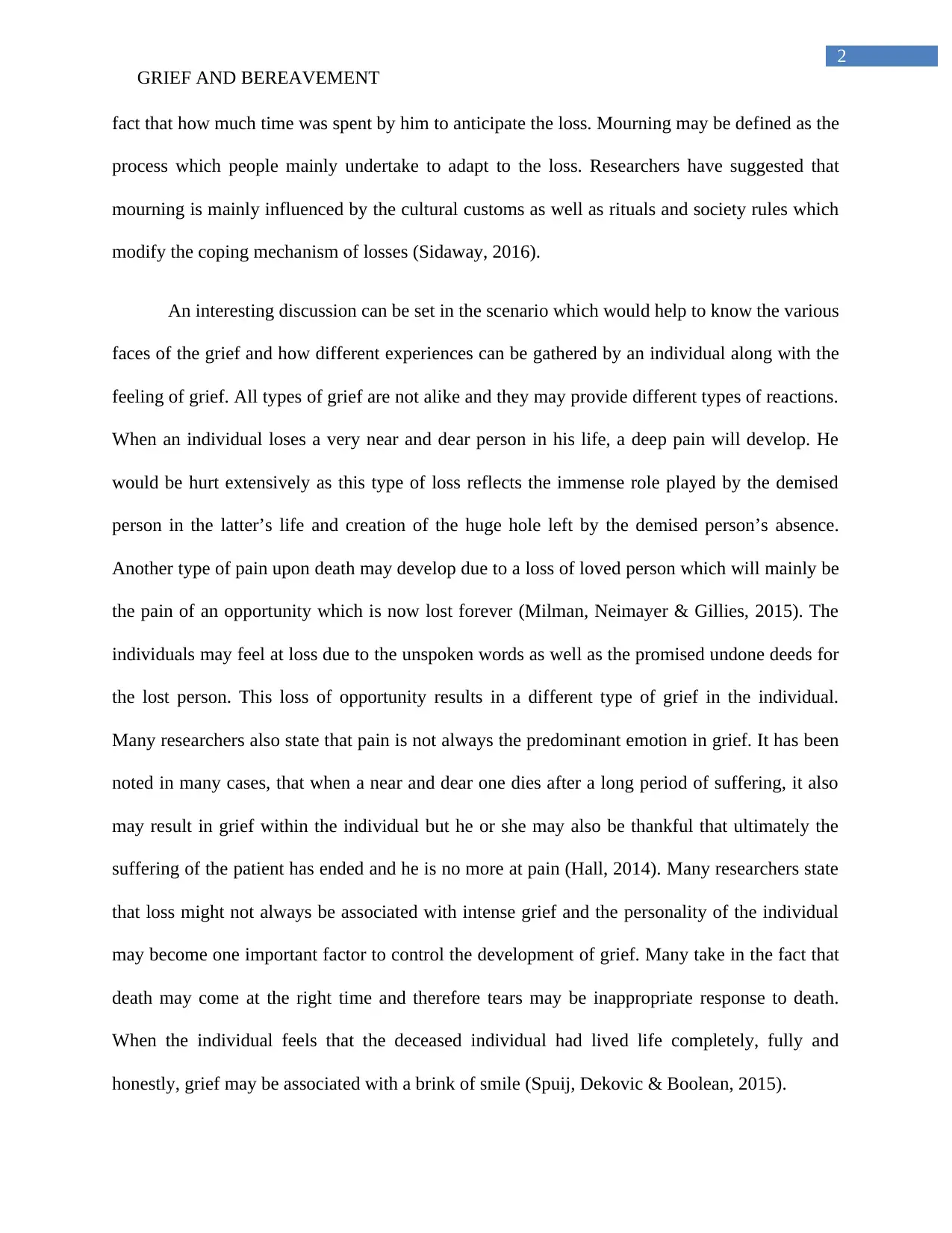
2
GRIEF AND BEREAVEMENT
fact that how much time was spent by him to anticipate the loss. Mourning may be defined as the
process which people mainly undertake to adapt to the loss. Researchers have suggested that
mourning is mainly influenced by the cultural customs as well as rituals and society rules which
modify the coping mechanism of losses (Sidaway, 2016).
An interesting discussion can be set in the scenario which would help to know the various
faces of the grief and how different experiences can be gathered by an individual along with the
feeling of grief. All types of grief are not alike and they may provide different types of reactions.
When an individual loses a very near and dear person in his life, a deep pain will develop. He
would be hurt extensively as this type of loss reflects the immense role played by the demised
person in the latter’s life and creation of the huge hole left by the demised person’s absence.
Another type of pain upon death may develop due to a loss of loved person which will mainly be
the pain of an opportunity which is now lost forever (Milman, Neimayer & Gillies, 2015). The
individuals may feel at loss due to the unspoken words as well as the promised undone deeds for
the lost person. This loss of opportunity results in a different type of grief in the individual.
Many researchers also state that pain is not always the predominant emotion in grief. It has been
noted in many cases, that when a near and dear one dies after a long period of suffering, it also
may result in grief within the individual but he or she may also be thankful that ultimately the
suffering of the patient has ended and he is no more at pain (Hall, 2014). Many researchers state
that loss might not always be associated with intense grief and the personality of the individual
may become one important factor to control the development of grief. Many take in the fact that
death may come at the right time and therefore tears may be inappropriate response to death.
When the individual feels that the deceased individual had lived life completely, fully and
honestly, grief may be associated with a brink of smile (Spuij, Dekovic & Boolean, 2015).
GRIEF AND BEREAVEMENT
fact that how much time was spent by him to anticipate the loss. Mourning may be defined as the
process which people mainly undertake to adapt to the loss. Researchers have suggested that
mourning is mainly influenced by the cultural customs as well as rituals and society rules which
modify the coping mechanism of losses (Sidaway, 2016).
An interesting discussion can be set in the scenario which would help to know the various
faces of the grief and how different experiences can be gathered by an individual along with the
feeling of grief. All types of grief are not alike and they may provide different types of reactions.
When an individual loses a very near and dear person in his life, a deep pain will develop. He
would be hurt extensively as this type of loss reflects the immense role played by the demised
person in the latter’s life and creation of the huge hole left by the demised person’s absence.
Another type of pain upon death may develop due to a loss of loved person which will mainly be
the pain of an opportunity which is now lost forever (Milman, Neimayer & Gillies, 2015). The
individuals may feel at loss due to the unspoken words as well as the promised undone deeds for
the lost person. This loss of opportunity results in a different type of grief in the individual.
Many researchers also state that pain is not always the predominant emotion in grief. It has been
noted in many cases, that when a near and dear one dies after a long period of suffering, it also
may result in grief within the individual but he or she may also be thankful that ultimately the
suffering of the patient has ended and he is no more at pain (Hall, 2014). Many researchers state
that loss might not always be associated with intense grief and the personality of the individual
may become one important factor to control the development of grief. Many take in the fact that
death may come at the right time and therefore tears may be inappropriate response to death.
When the individual feels that the deceased individual had lived life completely, fully and
honestly, grief may be associated with a brink of smile (Spuij, Dekovic & Boolean, 2015).
⊘ This is a preview!⊘
Do you want full access?
Subscribe today to unlock all pages.

Trusted by 1+ million students worldwide
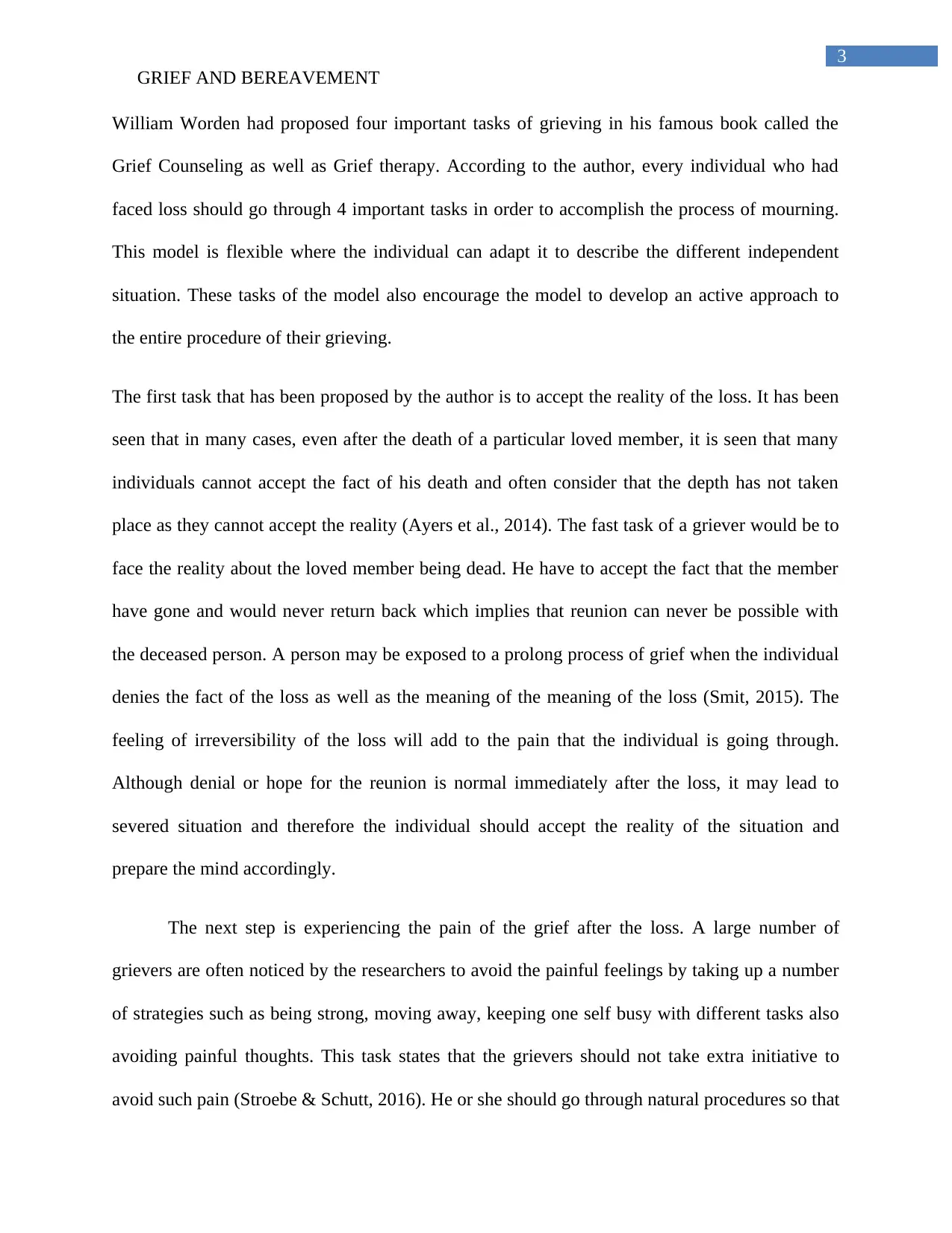
3
GRIEF AND BEREAVEMENT
William Worden had proposed four important tasks of grieving in his famous book called the
Grief Counseling as well as Grief therapy. According to the author, every individual who had
faced loss should go through 4 important tasks in order to accomplish the process of mourning.
This model is flexible where the individual can adapt it to describe the different independent
situation. These tasks of the model also encourage the model to develop an active approach to
the entire procedure of their grieving.
The first task that has been proposed by the author is to accept the reality of the loss. It has been
seen that in many cases, even after the death of a particular loved member, it is seen that many
individuals cannot accept the fact of his death and often consider that the depth has not taken
place as they cannot accept the reality (Ayers et al., 2014). The fast task of a griever would be to
face the reality about the loved member being dead. He have to accept the fact that the member
have gone and would never return back which implies that reunion can never be possible with
the deceased person. A person may be exposed to a prolong process of grief when the individual
denies the fact of the loss as well as the meaning of the meaning of the loss (Smit, 2015). The
feeling of irreversibility of the loss will add to the pain that the individual is going through.
Although denial or hope for the reunion is normal immediately after the loss, it may lead to
severed situation and therefore the individual should accept the reality of the situation and
prepare the mind accordingly.
The next step is experiencing the pain of the grief after the loss. A large number of
grievers are often noticed by the researchers to avoid the painful feelings by taking up a number
of strategies such as being strong, moving away, keeping one self busy with different tasks also
avoiding painful thoughts. This task states that the grievers should not take extra initiative to
avoid such pain (Stroebe & Schutt, 2016). He or she should go through natural procedures so that
GRIEF AND BEREAVEMENT
William Worden had proposed four important tasks of grieving in his famous book called the
Grief Counseling as well as Grief therapy. According to the author, every individual who had
faced loss should go through 4 important tasks in order to accomplish the process of mourning.
This model is flexible where the individual can adapt it to describe the different independent
situation. These tasks of the model also encourage the model to develop an active approach to
the entire procedure of their grieving.
The first task that has been proposed by the author is to accept the reality of the loss. It has been
seen that in many cases, even after the death of a particular loved member, it is seen that many
individuals cannot accept the fact of his death and often consider that the depth has not taken
place as they cannot accept the reality (Ayers et al., 2014). The fast task of a griever would be to
face the reality about the loved member being dead. He have to accept the fact that the member
have gone and would never return back which implies that reunion can never be possible with
the deceased person. A person may be exposed to a prolong process of grief when the individual
denies the fact of the loss as well as the meaning of the meaning of the loss (Smit, 2015). The
feeling of irreversibility of the loss will add to the pain that the individual is going through.
Although denial or hope for the reunion is normal immediately after the loss, it may lead to
severed situation and therefore the individual should accept the reality of the situation and
prepare the mind accordingly.
The next step is experiencing the pain of the grief after the loss. A large number of
grievers are often noticed by the researchers to avoid the painful feelings by taking up a number
of strategies such as being strong, moving away, keeping one self busy with different tasks also
avoiding painful thoughts. This task states that the grievers should not take extra initiative to
avoid such pain (Stroebe & Schutt, 2016). He or she should go through natural procedures so that
Paraphrase This Document
Need a fresh take? Get an instant paraphrase of this document with our AI Paraphraser
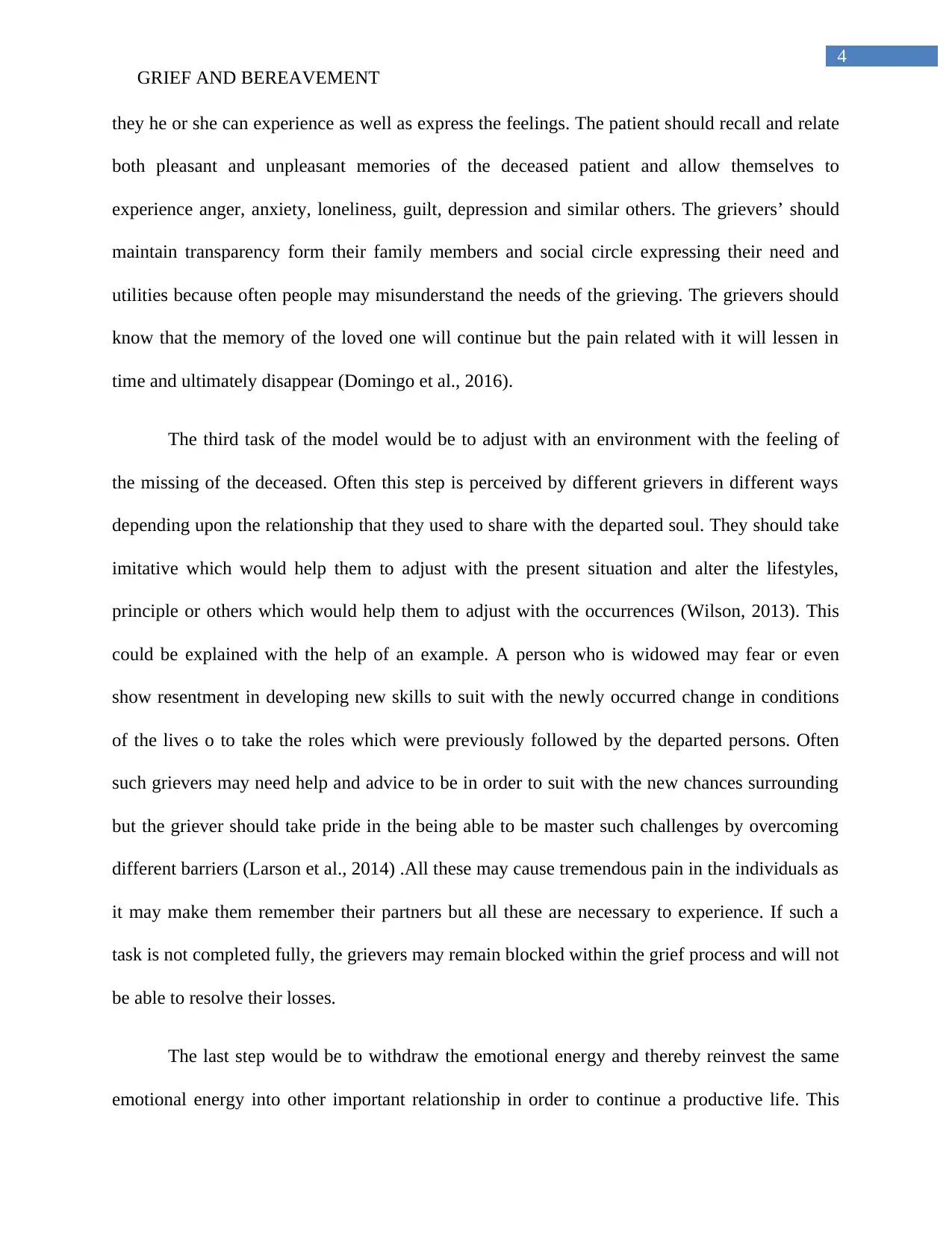
4
GRIEF AND BEREAVEMENT
they he or she can experience as well as express the feelings. The patient should recall and relate
both pleasant and unpleasant memories of the deceased patient and allow themselves to
experience anger, anxiety, loneliness, guilt, depression and similar others. The grievers’ should
maintain transparency form their family members and social circle expressing their need and
utilities because often people may misunderstand the needs of the grieving. The grievers should
know that the memory of the loved one will continue but the pain related with it will lessen in
time and ultimately disappear (Domingo et al., 2016).
The third task of the model would be to adjust with an environment with the feeling of
the missing of the deceased. Often this step is perceived by different grievers in different ways
depending upon the relationship that they used to share with the departed soul. They should take
imitative which would help them to adjust with the present situation and alter the lifestyles,
principle or others which would help them to adjust with the occurrences (Wilson, 2013). This
could be explained with the help of an example. A person who is widowed may fear or even
show resentment in developing new skills to suit with the newly occurred change in conditions
of the lives o to take the roles which were previously followed by the departed persons. Often
such grievers may need help and advice to be in order to suit with the new chances surrounding
but the griever should take pride in the being able to be master such challenges by overcoming
different barriers (Larson et al., 2014) .All these may cause tremendous pain in the individuals as
it may make them remember their partners but all these are necessary to experience. If such a
task is not completed fully, the grievers may remain blocked within the grief process and will not
be able to resolve their losses.
The last step would be to withdraw the emotional energy and thereby reinvest the same
emotional energy into other important relationship in order to continue a productive life. This
GRIEF AND BEREAVEMENT
they he or she can experience as well as express the feelings. The patient should recall and relate
both pleasant and unpleasant memories of the deceased patient and allow themselves to
experience anger, anxiety, loneliness, guilt, depression and similar others. The grievers’ should
maintain transparency form their family members and social circle expressing their need and
utilities because often people may misunderstand the needs of the grieving. The grievers should
know that the memory of the loved one will continue but the pain related with it will lessen in
time and ultimately disappear (Domingo et al., 2016).
The third task of the model would be to adjust with an environment with the feeling of
the missing of the deceased. Often this step is perceived by different grievers in different ways
depending upon the relationship that they used to share with the departed soul. They should take
imitative which would help them to adjust with the present situation and alter the lifestyles,
principle or others which would help them to adjust with the occurrences (Wilson, 2013). This
could be explained with the help of an example. A person who is widowed may fear or even
show resentment in developing new skills to suit with the newly occurred change in conditions
of the lives o to take the roles which were previously followed by the departed persons. Often
such grievers may need help and advice to be in order to suit with the new chances surrounding
but the griever should take pride in the being able to be master such challenges by overcoming
different barriers (Larson et al., 2014) .All these may cause tremendous pain in the individuals as
it may make them remember their partners but all these are necessary to experience. If such a
task is not completed fully, the grievers may remain blocked within the grief process and will not
be able to resolve their losses.
The last step would be to withdraw the emotional energy and thereby reinvest the same
emotional energy into other important relationship in order to continue a productive life. This
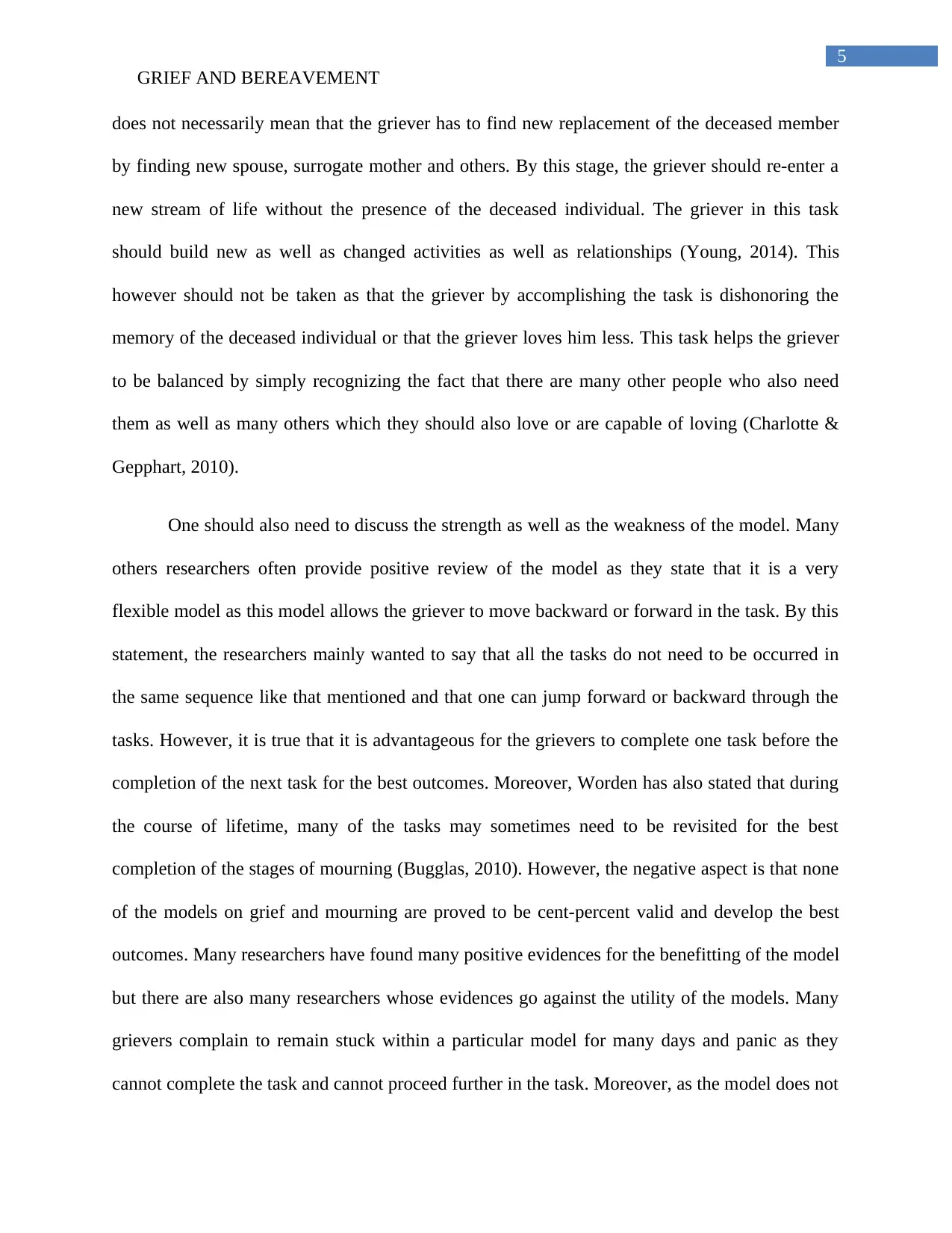
5
GRIEF AND BEREAVEMENT
does not necessarily mean that the griever has to find new replacement of the deceased member
by finding new spouse, surrogate mother and others. By this stage, the griever should re-enter a
new stream of life without the presence of the deceased individual. The griever in this task
should build new as well as changed activities as well as relationships (Young, 2014). This
however should not be taken as that the griever by accomplishing the task is dishonoring the
memory of the deceased individual or that the griever loves him less. This task helps the griever
to be balanced by simply recognizing the fact that there are many other people who also need
them as well as many others which they should also love or are capable of loving (Charlotte &
Gepphart, 2010).
One should also need to discuss the strength as well as the weakness of the model. Many
others researchers often provide positive review of the model as they state that it is a very
flexible model as this model allows the griever to move backward or forward in the task. By this
statement, the researchers mainly wanted to say that all the tasks do not need to be occurred in
the same sequence like that mentioned and that one can jump forward or backward through the
tasks. However, it is true that it is advantageous for the grievers to complete one task before the
completion of the next task for the best outcomes. Moreover, Worden has also stated that during
the course of lifetime, many of the tasks may sometimes need to be revisited for the best
completion of the stages of mourning (Bugglas, 2010). However, the negative aspect is that none
of the models on grief and mourning are proved to be cent-percent valid and develop the best
outcomes. Many researchers have found many positive evidences for the benefitting of the model
but there are also many researchers whose evidences go against the utility of the models. Many
grievers complain to remain stuck within a particular model for many days and panic as they
cannot complete the task and cannot proceed further in the task. Moreover, as the model does not
GRIEF AND BEREAVEMENT
does not necessarily mean that the griever has to find new replacement of the deceased member
by finding new spouse, surrogate mother and others. By this stage, the griever should re-enter a
new stream of life without the presence of the deceased individual. The griever in this task
should build new as well as changed activities as well as relationships (Young, 2014). This
however should not be taken as that the griever by accomplishing the task is dishonoring the
memory of the deceased individual or that the griever loves him less. This task helps the griever
to be balanced by simply recognizing the fact that there are many other people who also need
them as well as many others which they should also love or are capable of loving (Charlotte &
Gepphart, 2010).
One should also need to discuss the strength as well as the weakness of the model. Many
others researchers often provide positive review of the model as they state that it is a very
flexible model as this model allows the griever to move backward or forward in the task. By this
statement, the researchers mainly wanted to say that all the tasks do not need to be occurred in
the same sequence like that mentioned and that one can jump forward or backward through the
tasks. However, it is true that it is advantageous for the grievers to complete one task before the
completion of the next task for the best outcomes. Moreover, Worden has also stated that during
the course of lifetime, many of the tasks may sometimes need to be revisited for the best
completion of the stages of mourning (Bugglas, 2010). However, the negative aspect is that none
of the models on grief and mourning are proved to be cent-percent valid and develop the best
outcomes. Many researchers have found many positive evidences for the benefitting of the model
but there are also many researchers whose evidences go against the utility of the models. Many
grievers complain to remain stuck within a particular model for many days and panic as they
cannot complete the task and cannot proceed further in the task. Moreover, as the model does not
⊘ This is a preview!⊘
Do you want full access?
Subscribe today to unlock all pages.

Trusted by 1+ million students worldwide

6
GRIEF AND BEREAVEMENT
set any timeframes, often it is found that grievers remain shifting form one task to another unable
to finally come out of the model successfully or may require high time which affects quality life
(Currier et al., 2015.
Hence, from the entire essay, it can be concluded loss of loved one often result an
individual to develop grief and bereavement. These in turn may lead to physical disorders and
mental health may also be compromised. The individuals may withdraw them completely from
their social life. All these may affect their quality of life making them enveloped in pain, distress,
stress and despair. Hence, following the Worden’s theory model of mourning may provide great
guidance to the grievers. They may undertake the four important tasks successfully to overcome
their present feeling of pain and loss and develop their life for betterment and enjoy a quality life
once again.
GRIEF AND BEREAVEMENT
set any timeframes, often it is found that grievers remain shifting form one task to another unable
to finally come out of the model successfully or may require high time which affects quality life
(Currier et al., 2015.
Hence, from the entire essay, it can be concluded loss of loved one often result an
individual to develop grief and bereavement. These in turn may lead to physical disorders and
mental health may also be compromised. The individuals may withdraw them completely from
their social life. All these may affect their quality of life making them enveloped in pain, distress,
stress and despair. Hence, following the Worden’s theory model of mourning may provide great
guidance to the grievers. They may undertake the four important tasks successfully to overcome
their present feeling of pain and loss and develop their life for betterment and enjoy a quality life
once again.
Paraphrase This Document
Need a fresh take? Get an instant paraphrase of this document with our AI Paraphraser
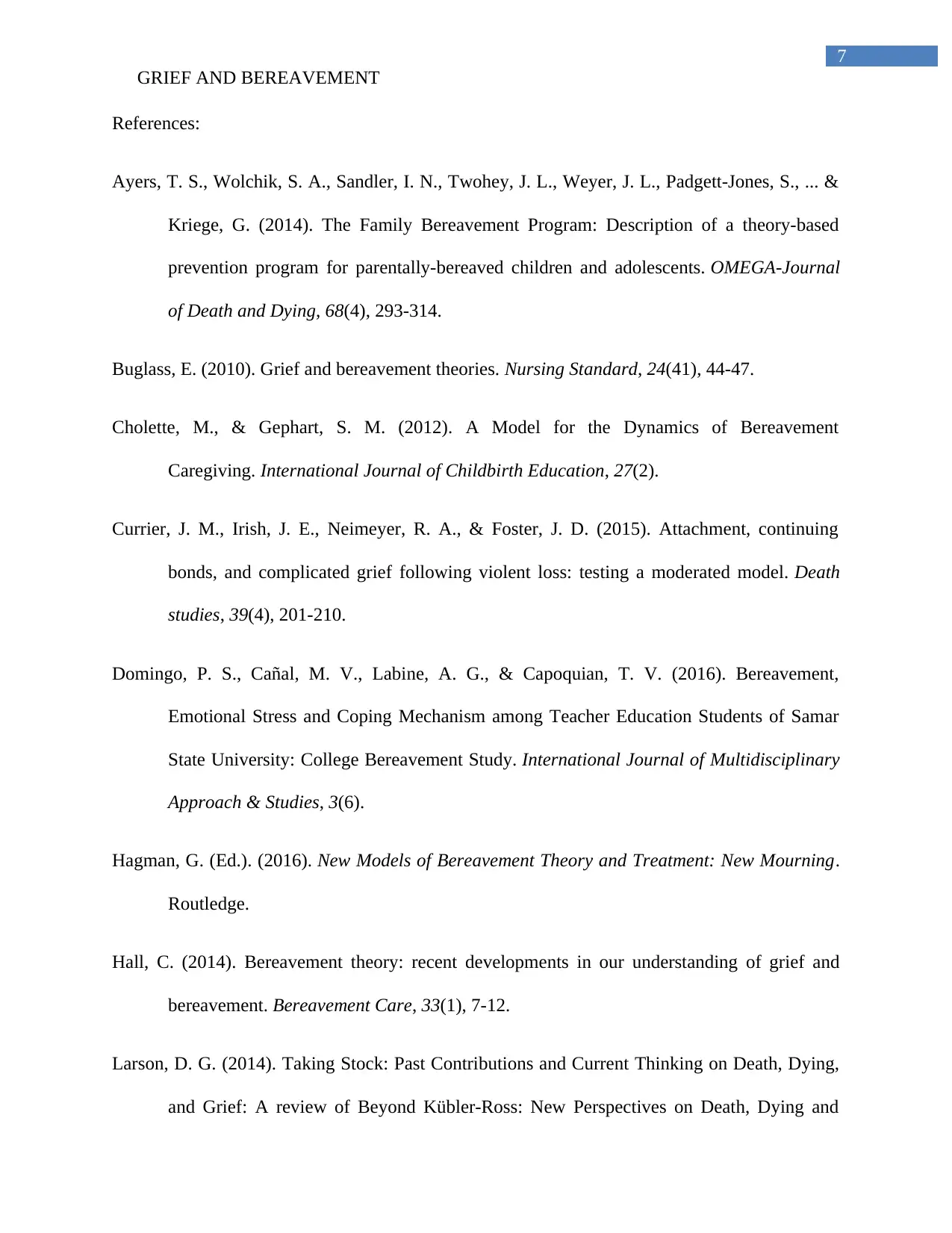
7
GRIEF AND BEREAVEMENT
References:
Ayers, T. S., Wolchik, S. A., Sandler, I. N., Twohey, J. L., Weyer, J. L., Padgett-Jones, S., ... &
Kriege, G. (2014). The Family Bereavement Program: Description of a theory-based
prevention program for parentally-bereaved children and adolescents. OMEGA-Journal
of Death and Dying, 68(4), 293-314.
Buglass, E. (2010). Grief and bereavement theories. Nursing Standard, 24(41), 44-47.
Cholette, M., & Gephart, S. M. (2012). A Model for the Dynamics of Bereavement
Caregiving. International Journal of Childbirth Education, 27(2).
Currier, J. M., Irish, J. E., Neimeyer, R. A., & Foster, J. D. (2015). Attachment, continuing
bonds, and complicated grief following violent loss: testing a moderated model. Death
studies, 39(4), 201-210.
Domingo, P. S., Cañal, M. V., Labine, A. G., & Capoquian, T. V. (2016). Bereavement,
Emotional Stress and Coping Mechanism among Teacher Education Students of Samar
State University: College Bereavement Study. International Journal of Multidisciplinary
Approach & Studies, 3(6).
Hagman, G. (Ed.). (2016). New Models of Bereavement Theory and Treatment: New Mourning.
Routledge.
Hall, C. (2014). Bereavement theory: recent developments in our understanding of grief and
bereavement. Bereavement Care, 33(1), 7-12.
Larson, D. G. (2014). Taking Stock: Past Contributions and Current Thinking on Death, Dying,
and Grief: A review of Beyond Kübler-Ross: New Perspectives on Death, Dying and
GRIEF AND BEREAVEMENT
References:
Ayers, T. S., Wolchik, S. A., Sandler, I. N., Twohey, J. L., Weyer, J. L., Padgett-Jones, S., ... &
Kriege, G. (2014). The Family Bereavement Program: Description of a theory-based
prevention program for parentally-bereaved children and adolescents. OMEGA-Journal
of Death and Dying, 68(4), 293-314.
Buglass, E. (2010). Grief and bereavement theories. Nursing Standard, 24(41), 44-47.
Cholette, M., & Gephart, S. M. (2012). A Model for the Dynamics of Bereavement
Caregiving. International Journal of Childbirth Education, 27(2).
Currier, J. M., Irish, J. E., Neimeyer, R. A., & Foster, J. D. (2015). Attachment, continuing
bonds, and complicated grief following violent loss: testing a moderated model. Death
studies, 39(4), 201-210.
Domingo, P. S., Cañal, M. V., Labine, A. G., & Capoquian, T. V. (2016). Bereavement,
Emotional Stress and Coping Mechanism among Teacher Education Students of Samar
State University: College Bereavement Study. International Journal of Multidisciplinary
Approach & Studies, 3(6).
Hagman, G. (Ed.). (2016). New Models of Bereavement Theory and Treatment: New Mourning.
Routledge.
Hall, C. (2014). Bereavement theory: recent developments in our understanding of grief and
bereavement. Bereavement Care, 33(1), 7-12.
Larson, D. G. (2014). Taking Stock: Past Contributions and Current Thinking on Death, Dying,
and Grief: A review of Beyond Kübler-Ross: New Perspectives on Death, Dying and

8
GRIEF AND BEREAVEMENT
Grief edited by Kenneth J. Doka and Amy S. Tucci. Washington, DC: Hospice
Foundation of America, 2011. 156 pp.(ISBN: 9781893349131).
Maddrell, A. (2016). Mapping grief. A conceptual framework for understanding the spatial
dimensions of bereavement, mourning and remembrance. Social & Cultural
Geography, 17(2), 166-188.
Milman, E., Neimeyer, R. A., & Gillies, J. (2015). Meaning of Loss Codebook
(MLC). Techniques of Grief Therapy: Assessment and Intervention, 51.
Parkes, C. M., & Prigerson, H. G. (2013). Bereavement: Studies of grief in adult life. Routledge.
Sidaway, J. D. (2016). Deathscapes: Spaces for death, dying, mourning and remembrance.
Routledge.
Smit, C. (2015). Theories and models of grief: Applications to professional practice. Whitireia
Nursing & Health Journal, (22), 33.
Spuij, M., Dekovic, M., & Boelen, P. A. (2015). An open trial of ‘Grief‐Help’: A cognitive–
behavioural treatment for prolonged grief in children and adolescents. Clinical
Psychology & Psychotherapy, 22(2), 185-192.
Stroebe, M., & Schut, H. (2016). Overload: A missing link in the dual process model?. OMEGA-
Journal of Death and Dying, 74(1), 96-109.
Wilson, S. (2003). Lost realities: Sandra Wilson learned more about grief and dementia after
reading a continuing professional development article. Nursing Standard, 17(37), 26-26.
GRIEF AND BEREAVEMENT
Grief edited by Kenneth J. Doka and Amy S. Tucci. Washington, DC: Hospice
Foundation of America, 2011. 156 pp.(ISBN: 9781893349131).
Maddrell, A. (2016). Mapping grief. A conceptual framework for understanding the spatial
dimensions of bereavement, mourning and remembrance. Social & Cultural
Geography, 17(2), 166-188.
Milman, E., Neimeyer, R. A., & Gillies, J. (2015). Meaning of Loss Codebook
(MLC). Techniques of Grief Therapy: Assessment and Intervention, 51.
Parkes, C. M., & Prigerson, H. G. (2013). Bereavement: Studies of grief in adult life. Routledge.
Sidaway, J. D. (2016). Deathscapes: Spaces for death, dying, mourning and remembrance.
Routledge.
Smit, C. (2015). Theories and models of grief: Applications to professional practice. Whitireia
Nursing & Health Journal, (22), 33.
Spuij, M., Dekovic, M., & Boelen, P. A. (2015). An open trial of ‘Grief‐Help’: A cognitive–
behavioural treatment for prolonged grief in children and adolescents. Clinical
Psychology & Psychotherapy, 22(2), 185-192.
Stroebe, M., & Schut, H. (2016). Overload: A missing link in the dual process model?. OMEGA-
Journal of Death and Dying, 74(1), 96-109.
Wilson, S. (2003). Lost realities: Sandra Wilson learned more about grief and dementia after
reading a continuing professional development article. Nursing Standard, 17(37), 26-26.
⊘ This is a preview!⊘
Do you want full access?
Subscribe today to unlock all pages.

Trusted by 1+ million students worldwide

9
GRIEF AND BEREAVEMENT
Young, H. (2017). Overcoming barriers to grief: supporting bereaved people with profound
intellectual and multiple disabilities. International Journal of Developmental
Disabilities, 63(3), 131-137.
GRIEF AND BEREAVEMENT
Young, H. (2017). Overcoming barriers to grief: supporting bereaved people with profound
intellectual and multiple disabilities. International Journal of Developmental
Disabilities, 63(3), 131-137.
1 out of 10
Related Documents
Your All-in-One AI-Powered Toolkit for Academic Success.
+13062052269
info@desklib.com
Available 24*7 on WhatsApp / Email
![[object Object]](/_next/static/media/star-bottom.7253800d.svg)
Unlock your academic potential
Copyright © 2020–2025 A2Z Services. All Rights Reserved. Developed and managed by ZUCOL.





